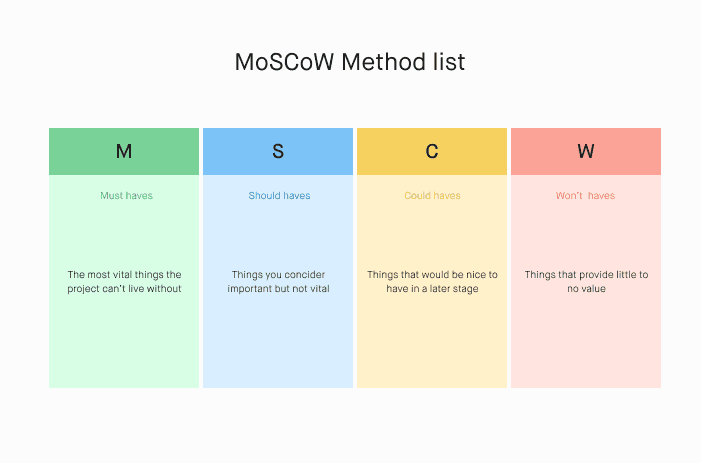A MoSCoW list, what is it and what is it good for?
Jesson
Lead designer
Lead designer
We work on a wide variety of digital products and we often tailor our approach to the type of product we need to develop. That said, there are a number of steps in our app development process that we always apply. A part that we never skip in this process is a MoSCoW list, also called the MoSCoW Method.
The reason why we do this is simple: A project often becomes cluttered and quickly runs out due to the amount of functionalities that are put into it. Are all these functionalities really necessary for a first phase and how do we keep the project manageable? The MoSCoW method is the most transparent way for us to gain structure and overview.
At its core, the MoSCoW method is nothing more than a prioritization method that can be applied to any project and provides a prioritized to-do list that is achievable, also known as a MoSCoW list.
The purpose of the process is to divide tasks into four categories; Must-haves, Should-haves, Could-haves and Won't-haves. As you will probably understand, Must has the highest priority and Won't the lowest. Now you probably also see where the capital letters in MoSCoW come from.

One of the main advantages of a MoSCoW list is that important decisions must be made before a project that determines the direction that such a project will take. It will be determined together with the customer which functionalities are absolutely fundamental for the product (Must), which are of less importance (Should), and which are simply nice-to-haves (could), but also which offer absolutely no added value for the product. product (won't).
This whole process allows us to divide the project into three phases.
Phase 1 - An MVP to test the product.
Phase 2 - Make improvements and add new functionalities (Should haves).
Phase 3 - Again making improvements and adding new functionalities (Could haves).
The advantage of dividing a project into these steps means that we can very quickly create a first version and test it with real users, which in turn allows us to generate feedback and make improvements where necessary, which in turn enables us to make better products.
In addition, there are many more advantages. Here are a few advantages:
In summary, the MoSCoW method helps us as a product team as well as the customer to make the right choices easily and efficiently and to set clear priorities. It gives a clear direction to the project and activates productivity. However, this method is not perfect. It requires a lot of attention and the right people to make the right choices. Nevertheless, the MoSCoW method is a powerful approach and we do not tackle a project without applying the method.
Have an unsolvable problem or audacious idea? We’d love to hear about it.
Talk to Sander